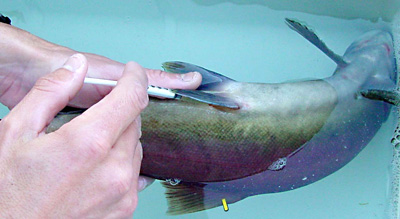Snake River Sockeye Salmon Captive Broodstock Program
The Snake River Sockeye Salmon Captive Broodstock Program was created in May 1991 – before the National Oceanic & Atmospheric Administration listed Snake River sockeye salmon Oncorhynchus nerka as endangered under the Endangered Species Act of 1973, on November 20, 1991.
The Captive Broodstock Program was initiated to conserve and rebuild the Redfish Lake sockeye salmon stock in the Sawtooth Valley of central Idaho. Historically, five Sawtooth Valley lakes – Alturas, Pettit, Redfish, Stanley and Yellowbelly – supported sockeye salmon. Restoration efforts today are focused on Alturas, Pettit, and Redfish lakes.

Biologist working with anesthetized fish.
The immediate goal of the program is to utilize captive broodstock technology to conserve the population’s unique genetics. Long-term goals include increasing the number of individuals in the population to address NOAA’s interim abundance guidelines and to provide sport and treaty harvest opportunity. Draft ESA delisting criteria for Snake River sockeye salmon includes the return of 1,000 adults to Redfish Lake, 500 adults to Pettit Lake, and 500 adults to Alturas Lake for two generations. Interim abundance targets must be met without relying on hatchery production, but on natural origin adults.
Project cooperators include representatives from Idaho Fish and Game, NOAA, Oregon Department of Fish & Wildlife, Shoshone-Bannock Tribes, and the Bonneville Power Administration.
The program has five primary elements:- Captive broodstock program
- Production supplementation
- Habitat evaluations
- Genetics monitoring
- Monitoring and evaluation of fish supplemented back to the system
NOAA shares captive broodstock and adult supplementation responsibilities at Manchester Research Station, Burley Creek Fish Hatchery – Washington. Oregon Fish and Wildlife provides smolt production rearing at the Oxbow Fish Hatchery – Oregon. The Shoshone-Bannock Tribes conduct habitat and lake fertilization work. Bonneville Power Administration provides funding for project sponsors.
Idaho Department of Fish and Game’s participation in the program includes two primary areas of effort: 1) Sockeye salmon captive broodstock culture & supplementation. 2) Sockeye salmon research and evaluations.
Fish are trapped at the Redfish Lake Creek and at the Sawtooth Hatchery in the Sawtooth Valley just south of Stanley. The Eagle Fish Hatchery is the primary culture facility for broodstock rearing and spawning. Fertilized eggs are transferred to Sawtooth Fish Hatchery for continued culture through release. Eggs and fish are released into the habitat. Eyed eggs are planted in egg boxes in lakes in the fall. Pre-smolts are released directly to the lakes in the fall. Smolts are released to outlet streams in the spring, and prespawn adults are released to lakes in the fall. The eggs, smolts and fish are monitored to document the success of each strategy.
The research component of the program is responsible for post-release monitoring of eggs, juveniles and adults, as well as population monitoring and predator investigations. Additionally, personnel from the Eagle Fish Genetics Laboratory assist with genetic evaluations for program-specific research.
Specific language contained in draft FCRPS BiOps (2004-present) is credited with several changes to the program in the last few years:- Development of smolt rearing program at the Oxbow Fish Hatchery.
- Facility expansion for increased brood production at the Eagle Fish Hatchery.
- Funding to investigate the potential acquisition of additional smolt rearing for sockeye in Idaho.
The Eagle Fish Hatchery expansion project was completed in late-May near the town of Eagle, Idaho. The new facility allows broodstock production at Eagle to be doubled – from 400 adults per year class to 800 – and provides space for holding up to 400 pre-spawn anadromous adults in quarantine holding facilities.
Top of page
